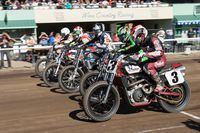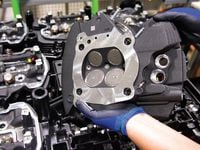Just now it’s become fashionable to regard US dirt-track as out of the hospital and recovering nicely, thanks to such encouraging developments as;
International interest, shown in the form of two successful all-comers 'Superprestigio' indoor short-track event in Spain, bringing together such unlikely combinations as World Champion road racer Marc Marquez and the graceful, calm American, Brad Baker.
The easy availability of "The small-block Chevy of dirt-track", the Kawasaki Ninja 650 twin, which has deservedly become by far the most numerous powerplant in the series. No more need to push out $24 grand in chips for a classic XR-750 Harley, plus rather more than that in persuasion fees to get it prepped by the dwindling number of men who really know how (as opposed to just knowing where all the parts go). Bryan Smith is this year's Grand National Champion on a Ninja-powered bike. This is real grass-roots racing. (Update: Cycle World's contributing dirt track racer Cory Texter has told us it costs about the same to put together a Harley-Davidson XR750 or a Ninja-powered bike. Large savings in running a Ninja come in much-reduced maintenance.
Rumblings and stirrings of possible Japanese interest in the series – Honda and Yamaha have gained approval of candidate engines. The list of approved engines is long.
Biggest of all, Indian gained approval of a "race-only 750 twin" and then filled in the blanks with their FTR-750, which has performed so well that teams who think they can afford it are lining up to buy production examples. This engine was professionally designed for racing by Polaris's 'Swissauto' division, aka 'Polaris Europe' – an R&D shop. Unlike the XR, it will not require big-end replacement for every national, and being water-cooled like the Ninja, it won't slow down after three laps as air-cooled bikes do.
Related Story:
So – everything's great, right? Cash-rich Harley will respond with a killer engine from Porsche, Kawasaki will jump in and put their shoulder behind the Ninja program, Yamaha will at last roll out something more substantial than press releases, and Honda will – well, we never know what Honda will do. Good jobs for all as factory teams vie for mainstream TV coverage in a new golden age of 45-foot tractor-trailer racing.
Stop. Who thinks life is that simple? Both inside and outside the sport, people have urgent questions about such an imagined future.
Dirt-track builders are concerned that Indian's FTR could destroy competition. Rules set maximum fuel system diameter at 38-mm back when every carburetor and throttle body had either a metering needle or a butterfly and throttle shaft in the way. Somehow gaining knowledge not available to me, the dirt-track paddock now knows that the FTR employs a rotating disc throttle that leaves a completely unobstructed 38-mm flow path to each cylinder. Making even less sense is that present rules allow engines of 751 -1100-cc to have induction systems up to 52-mm.
The paddock wonders how the prototype FTR was allowed to run at Santa Rosa even though rules supposedly prohibit such one-offs (but I do remember that the late Bill Boyce carried in his briefcase a blank sheet of paper on which he was empowered to write any rule "deemed essential to the well-being of the series").
The paddock, which consists of people who have lived their lives in this kind of racing, who spend all they have to continue in it, wonder if their way of life and their participation could be made irrelevant by a few "now you see it, now you don't" factory bikes. Factory programs exist at the pleasure of Marketing. To Marketing, racing is just one of many possible media buys. Harley's XR was designed in-house by draftsmen, engineers, and mechanics who understood racing. Today, their notional XR replacement, the 'Street'-based XG750R, is a contract job with Vance & Hines.
The AMA has run at least six previous programs to "revitalize dirt-track". Has anything changed that will make spectators flock to state fairgrounds this time, bringing TV coverage and major advertisers in their wake? The economy is down. Motorcycle sales are down. Could it be that we are persuading ourselves that better times are coming soon? In 2008, DC was buzzing over millions of green jobs and electric cars; where are they now?
Factory bikes will be fast. Builder-tuner Bill Werner, who began the Ninja movement, asks whether 34-second factory mile racing is as desirable as 36-second close racing. Some believe 34 second laps are too fast for existing facilities. Careful consideration required.
We wrongly assume the Big Four still have race shops and race personnel ready to be ordered back into action. But in fact there has been extensive personnel turnover since 2008 – the new B-school managers have no racing background. At Honda, team race gear was given away on a basis of "Load up anything in this room that's doesn't say HRC on it." One remaining transporter is said to be sitting somewhere on low tires, needing paint. The products these companies now desperately need to sell – entry-level 300s and 4-wheelers – have little connection to racing. So our expectations have to be realistic.
So far, builders of engines over 750-cc have musclebound themselves by building big horsepower that the spec Dunlop tire can't handle. What happens if someone builds a usable dirt-track torque curve and starts cleaning up?
These points deserve thoughtful consideration. It's encouraging to hear a rumor that Matt Levatich, Harley's current CEO (who holds a MechE from RPI), recently replaced the CVO tourer displayed in his office with an XR750. That suggests tradition may still count on Juneau Avenue. We're glad that dirt-track has created buzz. Bill Werner estimates that 60-70% of those in the paddock at present have negative net worth (that's certainly how I went racing in the 1970s!), so the right kind of factory involvement could help. The wrong kind could hurt (jump in, dominate until the next economic dip, then switch off). I very much dislike jargon, but the term "stakeholder" has utility here; the people who are the sport – its stakeholders in the paddock – must have a voice in its future direction.

/cloudfront-us-east-1.images.arcpublishing.com/octane/7TO4TMPM6JBJJPBWUMT35TJHHA.jpg)
/cloudfront-us-east-1.images.arcpublishing.com/octane/3CANJMY47BH6BNPDAODAUD3CWQ.jpg)
/cloudfront-us-east-1.images.arcpublishing.com/octane/4IGJJZ6HWNAIHJ343U7CUH4WC4.jpg)
/cloudfront-us-east-1.images.arcpublishing.com/octane/BP5NOY5NPVGOZIDU5FN7M42JMA.jpg)
/cloudfront-us-east-1.images.arcpublishing.com/octane/XH2ETEU4NVGDFNQO2XT2QQS5LU.jpg)
/cloudfront-us-east-1.images.arcpublishing.com/octane/TGJNNI474VFXFMS3YQDRIEKEFY.jpg)
/cloudfront-us-east-1.images.arcpublishing.com/octane/5QAQVX645VA3LKJFZ3C4Y2DTPI.jpg)
/cloudfront-us-east-1.images.arcpublishing.com/octane/45O2MZU525ATPB5GRG422ZTU54.jpg)
/cloudfront-us-east-1.images.arcpublishing.com/octane/WEWXDN2F2BD3DJYUJJX4RZIALA.jpg)
/cloudfront-us-east-1.images.arcpublishing.com/octane/VPDWRXQWRVGULBY7Z3JRGPTR2I.jpg)
/cloudfront-us-east-1.images.arcpublishing.com/octane/56QNDMMUA5EA3OCJINPCI2QZGA.jpg)
/cloudfront-us-east-1.images.arcpublishing.com/octane/BHOJALDF55CPXGFWVLVKBPYZZI.jpg)
/cloudfront-us-east-1.images.arcpublishing.com/octane/BRQMHRCC4FH5HK4D3HUMG6XEKM.jpg)
/cloudfront-us-east-1.images.arcpublishing.com/octane/2CPX3CKQZFFT5H2ISBRTCIAUPY.jpg)
/cloudfront-us-east-1.images.arcpublishing.com/octane/W6JSA4VWCFFDDAAN3AAWO6ZTPE.jpg)
/cloudfront-us-east-1.images.arcpublishing.com/octane/KJ34QPKSPFASHEGWY6FP7Z6C4M.jpg)
/cloudfront-us-east-1.images.arcpublishing.com/octane/3EGYOQSTNVCKZBKYRGZXPWE4XA.jpg)
/cloudfront-us-east-1.images.arcpublishing.com/octane/ZIQ26VLDXJFQBFVPRQ6QL5XFXE.jpg)
/cloudfront-us-east-1.images.arcpublishing.com/octane/RPFWTIVIXBCNRGFI43WNFCABUY.jpg)
/cloudfront-us-east-1.images.arcpublishing.com/octane/R43RXKVKXZAZ3PMB4UKAJRTVBU.jpg)
/cloudfront-us-east-1.images.arcpublishing.com/octane/35RWQS456ZAZFGSE7YVOXOR5YE.jpg)

/cloudfront-us-east-1.images.arcpublishing.com/octane/DCO27D4S45BYNNZTZLWRMCH44M.jpg)
/cloudfront-us-east-1.images.arcpublishing.com/octane/GFK6LFGR7VGNJPH5GXAQRKTGKA.jpg)